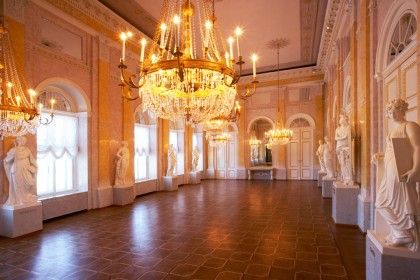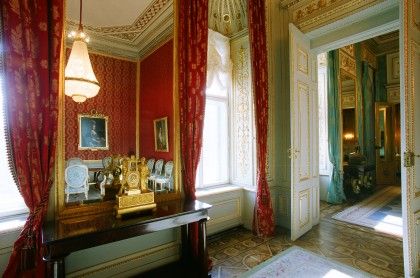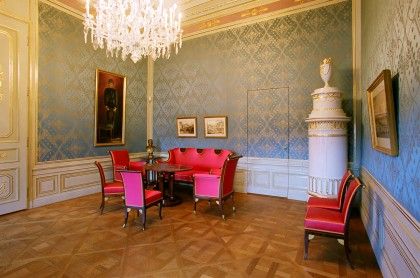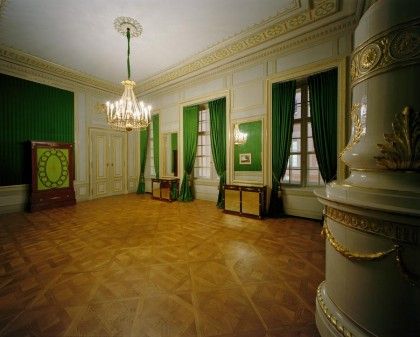Habsburg Staterooms in the Albertina Palace, Vienna
The central stateroom, the Hall of the Muses, was used as a dining room and as a glamorous venue for soirées and balls. The grand hall was transformed into a sea of light by five crystal chandeliers and 258 candles set in a rosette frieze that ran around the hall.
The opulence is enhanced by precious stucco marble wall panels and pilasters, and gilded doors and decorative elements. The hall derives its name from the life-sized sculptures of Apollo and the nine Muses. The Canova-inspired sandstone figures with a mock marble finish were the work of a leading Viennese sculptor, Joseph Klieber (1773-1850)
The Study epitomises the splendour of the staterooms. The elegant decoration and use of costly materials date from the 1822-25 refurbishment carried out under Archduke Carl.
Testifying to the extraordinary richness of the earlier décor of Duke Albert of Saxe-Teschen’s time is the "Gold Cabinet" next door to the Study. The special alloy used in the gold-leaf decoration of this small room consists of 23-carat gold, 1/2-carat silver and 1/2-carat copper, and is still known today as "Albertina Gold".
"Tee" Salon © AnnA BlaU
Archduke Albrecht had the crimson-walled "Tee" Salon and the adjacent yellow "Billard" Room remodelled in 1867. The wall dividing them was moved by one bay, and the floors and the decorative elements of the panelling and the windows were all replaced.
(A note about "tea": From 1895, the best butter in Vienna came from the Teschen dairy farm owned by Archduke Friedrich, the last Habsburg resident of the Albertina palace. The abbreviation of the dairy’s name spelled the German word for tea. To this day quality butter is called "tea butter" in Austria.).
The palace residents and their guests would gather in the "Billard" Room for after-dinner entertainment. Duke Albert and Archduke Carl in particular preferred a game of billiards over cards
Audience Hall © AnnA BlaU
The two Empire-style rooms in which Princess Henriette of Nassau-Weilburg received her visitors have been preserved with little change since 1823.
In Austria, the Empire style had a whiff of the French Revolution about it, limiting its appeal among the imperial court and the aristocracy, which favoured the Biedermeier style.
In the Reception Room and the Audience Hall, the furniture pairs, the satinwood, mahogany and palisander parquet veneers, bright and matt gilding, and the delicate painting on the walls and ceiling create an overall atmosphere of tasteful elegance and superior craftsmanship.
Rococo Room © AnnA BlaU
In 1875, Archduke Albrecht, depicted in the large painting commanding his last military manoeuvre, had the room refurbished in Neo-Rococo, the only example of that style in the palace. His mother, Princess Henriette of Nassau-Weilburg, had used the room as her study.
After her death in 1829, it became the classroom of her six children, whose father, Archduke Carl, wanted them to receive a full education in the arts and sciences based on innovative curricula. One of the liberal-minded tutors he engaged was a botanist and music scholar who had trained as a lawyer. Many years later Ludwig von Köchel would dedicate his world-famous 1862 catalogue of Mozart’s works to his former pupil Archduke Albrecht.
Wedgwood Cabinet © AnnA BlaU
The charm of this room lies in the four large wooden wall panels that are elaborately painted with naturalistic scenes representing the classical elements earth, water, air and fire, and inlaid with porcelain reliefs depicting mythological subjects. The reliefs were made by the English china manufacturing company which Josiah Wedgwood had founded in 1759.
They originally adorned the Temple du Soleil in the park of Duke Albert’s Brussels residence, Laeken Castle. He brought them to Vienna when he and Archduchess Marie Christine fled the Netherlands in 1792.
Spanish Apartment © AnnA BlaU; Furniture: On permanent loan from the MAK-Austrian Museum of Applied Arts / Contemporary Art
In 1895, Archduke Friedrich created a suite of seven rooms as a residence for the Spanish royal family. His sister, Maria Christine (1858-1929), was the widow of Spanish King Alfonso XII, who had died in 1885 while she was pregnant with their only son, Alfonso XIII.
She lived in the Spanish Apartments until 1918, and Alfonso XIII stayed here on his frequent visits to Vienna. Only two rooms survived bomb damage at the end of World War II, the Small Apartment and the Large Apartment. Today they feature the original furnishings by Joseph Danhauser.
Death Chamber of Archduke Carl © AnnA BlaU; Furniture: On permanent loan from the MAK-Austrian Museum of Applied Arts / Contemporary Art
Instead of silk, the walls of the Oval Cabinet are covered with emerald green wallpaper, made by hand like the original wallpaper from 1829.
In the adjacent room, three pairs of Joseph Danhauser furniture from the 1823 refurbishment attest to the outstanding design and craftsmanship for which the Viennese manufacturer was world-renowned. Archduke Carl died in this room in 1847.

/https%3A%2F%2Fprofilepics.canalblog.com%2Fprofilepics%2F1%2F0%2F100183.jpg)










/http%3A%2F%2Fstorage.canalblog.com%2F28%2F30%2F119589%2F66105793_p.jpg)
/http%3A%2F%2Fstorage.canalblog.com%2F68%2F77%2F119589%2F57774838_p.jpg)
/http%3A%2F%2Fstorage.canalblog.com%2F22%2F39%2F119589%2F51409253_p.jpg)
/http%3A%2F%2Fstorage.canalblog.com%2F41%2F50%2F577050%2F42908289_o.jpg)